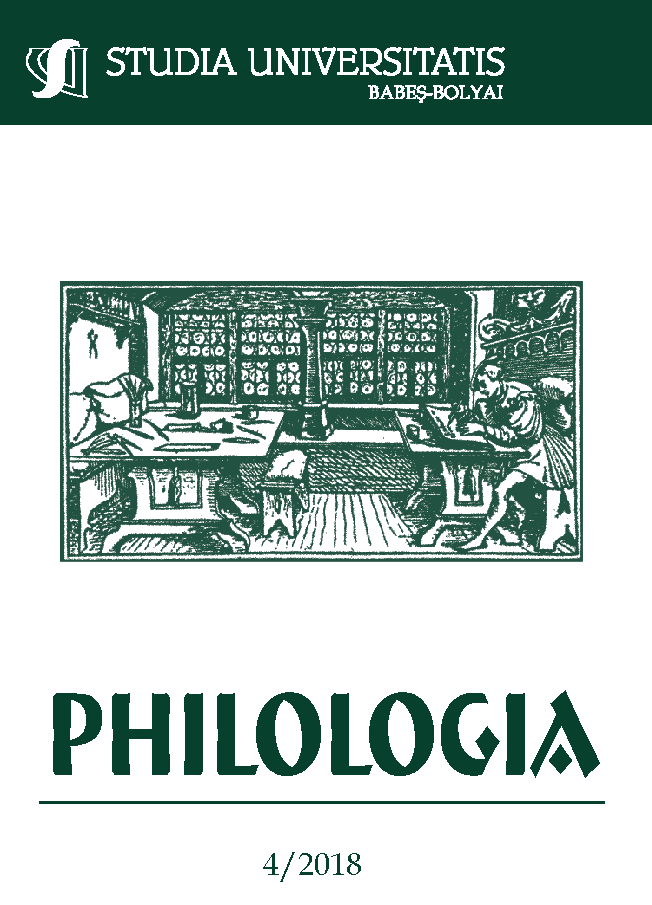JAMES JOYCE’S “ULYSSES”: READING THE SELF IN THE BODY
DOI:
https://doi.org/10.24193/subbphilo.2018.4.15Keywords:
Ulysses, the use of bodies, zone of non-consciousness, corporeal narratology, Agamben, Damasio, Punday.Abstract
James Joyce’s “Ulysses”: Reading the Self in the Body. Throughout this paper, my primary contention is that, as a book, Ulysses is a body of potentialities meant to help readers consubstantiate with their selves, with a special dedication for the Irish audience of the 1900s in particular. I suggest, in other words, that from a post-humanist perspective, the novel’s most metempsychotic feature remains its ability to guide readers out of their self-legitimising narratives and into the seat of their consciousness, the individual body. As the reader suspends their personal existence to engage with the body of the book, the latter helps deliver them into life-actual, all the while internalising a story unravelling its own textual cessation. This perspective on Ulysses involves re-tracing the human body within each narrative level, and the changes it undergoes through the novel’s embeddedness.
Rezumat. “Ulise” de James Joyce: Regăsirea Sinelui în Trup. Pe parcursul lucrării de față, teza principală este că romanul Ulise reprezintă o totalitate de entelehii menite să ghideze cititorul spre consubstanţialitate cu sinele, vizând, în mod special, publicul irlandez de la început de secol al XX-lea. Lucrarea evidenţiază cel mai metempsihotic aspect ale cărţii, anume abilitatea sa de a-l ghida pe cititor dincolo de povestirile auto-justificatoare ale sinelui şi spre originea conştiinţei umane, anume trupul individual. Astfel, corpul lui Ulise are menirea de a izbăvi cititorul întru faptul concret de a fi, chiar în timp ce acesta îşi suspendă existenţa individuală pentru actul citirii. O astfel de perspectivă asupra romanului necesită re-găsirea corpului uman în universul acţiunii propriu-zise, apoi continuând cu modul în care acesta este transformat de încadrările care se suprapun şi/sau intercalează cu cel dintâi.
Cuvinte cheie: Ulise, uzul corpurilor, zonă de non-conștiință, naratologie corporală, Agamben, Damasio, Punday.
References
Joyce, James. 1986. Ulysses. Edited by Hans Walter Gabler, Steppe Wolfhard and Melchior Claus. Vintage Books.
Agamben, Giorgio. 2017. The Omnibus Homo Sacer. Stanford University Press.
Bal, Mieke. 2009. Narratology: Introduction to the Theory of Narrative. Third edition, University of Toronto Press.
Bamberg, Michael. 2013. “Identity and Narration.” The Living Handbook of Narratology, 23 August 2013, lhn.uni-hamburg.de/article/identity-and-narration. Accessed 24 June 2018.
Benjamin, Walter. 1999. The Arcades Project. Translated by Howard Eiland and Kevin McLaughlin. Harvard University Press.
Benjamin, Walter. 2011. Early Writings: 1910-1917. Translated by Howard Eiland and others. Harvard University Press.
“Census Day, 2 April 1911.” The National Archives of Ireland, census.nationalarchives.ie/exhibition/dublin/census_day.html. Accessed 24 June 2018.
Damasio, Antonio. 2010. Self Comes to Mind: Constructing the Conscious Brain. Pantheon Books.
Damasio, Antonio. 1994. Descartes’ Error: Emotion, Reason and the Human Brain. Avon Books.
Fludernik, Monika. 2009. An Introduction to Narratology. Translated by Patricia Häusler-Greenfield and Monika Fludernik. Routledge.
Gifford, Don and Seidman, Robert. 1988. Ulysses Annotated: Notes for James Joyces’ Ulysses. Second edition. University of California Press.
Hunt, John. 2011. “Cracked Lookingglass.” The Joyce Project, 2011, joyceproject.com/notes/010056crackedlookingglass.html. Accessed 24 June 2018.
Hunt, John. 2017. “Proteus.” The Joyce Project, 2017, joyceproject.com/notes/030000proteus.html. Accessed 24 June 2018.
Hunt, John. 2018. “Leopold Bloom.” The Joyce Project, 2018, joyceproject.com/notes/040030leopoldbloom.html. Accessed 24 June 2018.
Kiberd, Declan. 2009. Ulysses and Us. Faber and Faber.
Kukkonen, Karin. 2014. “Plot.” The Living Handbook of Narratology, 24 March 2014, lhn.uni-hamburg.de/article/plot. Accessed 24 June 2018.
Malan, Greg. 2017. “Ricoeur on time: From Husserl to Augustine.” Theological Studies, vol. 73, no. 1.
Nabokov, Vladimir. 1982. Lectures on Literature. Edited by Fredson Bowers. Mariner Books.
Nussbaum, Martha. 2013. Political Emotions: Why Love Matters for Justice. Harvard University Press.
Pier, John. 2016. “Narrative Levels.” The Living Handbook of Narratology, 10 October 2016, lhn.uni-hamburg.de/article/narrative-levels-revised-version-uploaded-23-april-2014. Accessed 24 June 2018.
“Poverty and Health.” The National Archives of Ireland, census.nationalarchives.ie/exhibition/dublin/poverty_health.html. Accessed 24 June 2018.
Punday, Daniel. 2003. Narrative Bodies: Toward a Corporeal Narratology. Palgrave Macmillan,
Rushdie, Salman. “Truth, Lies, and Literature.” The New Yorker, 31 May 2018, newyorker.com/culture/cultural-comment/truth-lies-and-literature. Accessed 24 June 2018.
Trotter, David. 1999. “The Modernist Novel.” The Cambridge Companion to Modernism. Edited by Michael Levenson. Cambridge University Press, 70-100.
Downloads
Published
How to Cite
Issue
Section
License
Copyright (c) 2018 Studia Universitatis Babeș-Bolyai Philologia

This work is licensed under a Creative Commons Attribution-NonCommercial-NoDerivatives 4.0 International License.





 ©Studia Universitatis Babeş-Bolyai Philologia. Published by Babeș-Bolyai University.
©Studia Universitatis Babeş-Bolyai Philologia. Published by Babeș-Bolyai University.